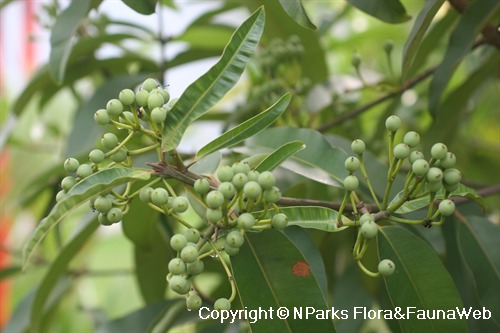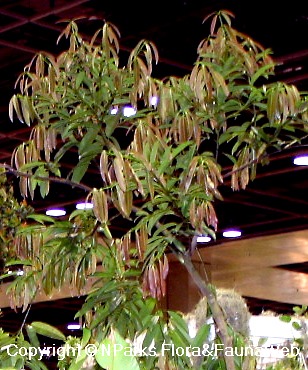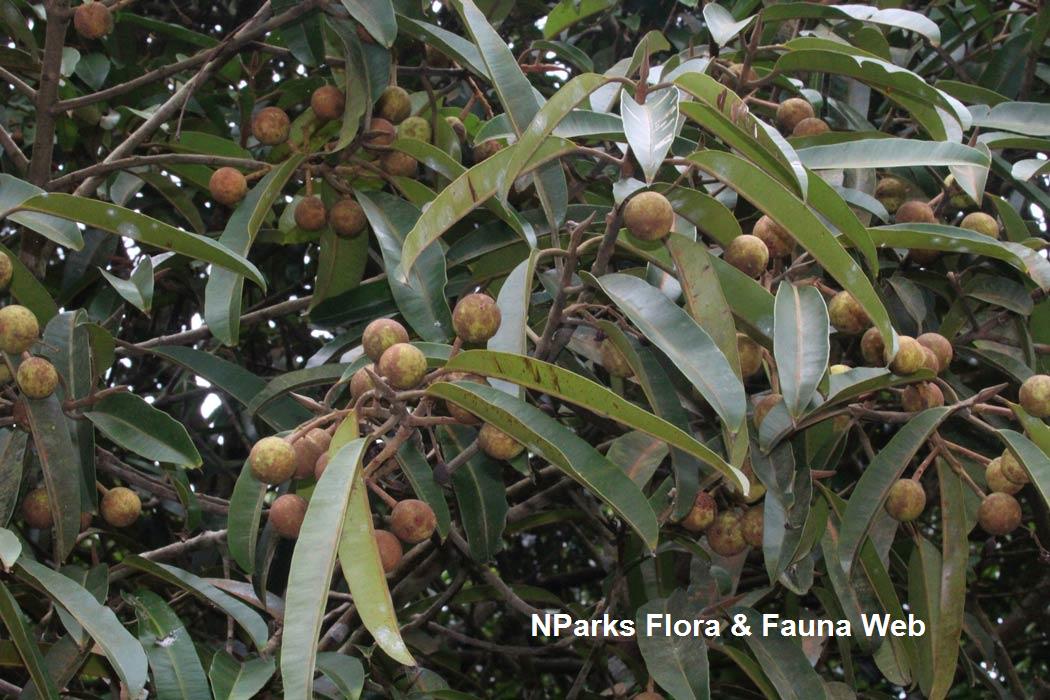_lowres.jpg)
Back
Calophyllum soulattri Burm.f.
| Family Name: | Calophyllaceae |
| Common Name: | Bintangor Bunut, Malang-Malang, Mintak |
Calophyllum soulattri, is a tree which can reach up to 25 m tall. It is found naturally along streams or peat swamps. The flowers are white with numerous yellow stamens. The wood can be used for house construction.
Name
Classifications and Characteristics
| Plant Division | Angiosperms (Flowering Seed Plants) (Dicotyledon) |
|---|---|
| Plant Growth Form | Tree (Medium (16m-30m), Small (6m-15m)) |
| Lifespan (in Singapore) | Perennial |
| Mode of Nutrition | Autotrophic |
| Maximum Height | 4.5 m to 26 m |
Biogeography
| Native Distribution | Andaman Islands, Vietnam, Thailand, Cambodia, to the Solomon Island, and northern Australia |
|---|---|
| Native Habitat | Terrestrial (Primary Rainforest, Secondary Rainforest, Freshwater Swamp Forest, Riverine), Shoreline (Mangrove Forest) |
| Preferred Climate Zone | Tropical |
Description and Ethnobotany
| Growth Form | It is a tree, from 4.5 m to 26 m tall. |
|---|---|
| Trunk | The trunk is rarely buttressed, spurred, occasionally with kneed roots when grown in swampy conditions. The outer bark is yellowish to pale brown in colour, with shallow, boat-shaped fissures. |
| Foliage | Its stalked, opposite leaves are ovate to elliptic or suboblong, 6.5-29 cm long by 2.4-10.2 cm wide, with prominent parallel secondary veins. New leaves are pinkish in colour, turning orange then beige before maturing to green. |
| Flowers | Its flower clusters consist of 7-21 flowers. Its while-petalled flowers are about 1 cm wide, with numerous stamens. The flowers are mildly fragrant. |
| Fruit | Its fruits are round, purplish black when ripe, 0.9-1.6 cm wide. |
| Habitat | It grows along the edges of rivers, and in lowland to lower montane rainforests, or sometimes in mangrove forests, up to 1700 m altitude. |
| Associated Fauna | Its flowers are pollinated by bees. The fruits are dispersed by birds. |
| Taxonomy | Calophyllum soulattri Burm.f. is observed to have first been incorrectly included in Singapore’s native flora by Keng (1990) and subsequent authors followed suit. Seah (2019) has clarified that Calophyllum soulattri Burm.f. is not native to Singapore. |
| Cultivation | It can be propagated by seed. |
| Etymology | Greek kalos, beautiful; Greek phyllon, a leaf, referring to the plant’s beautifully-veined leaf blades; soulattri, from a Sudanese name |
| Ethnobotanical Uses | Edible Plant Parts : Edible Fruits Food (Herb or Spice): The sourish fruits can be eaten. (Fruit or Vegetable) Medicinal: In Caroline Islands, the fresh bark from the shoots are used as medicine for women who have just given birth. The roots alone, together with the leaves, are used to treat rheumatic pains, and urinary tract infection, respectively. Timber & Products: The wood is used for masts, spars and in house construction. |
Landscaping Features
| Landscaping | It is suitable as an ornamental tree for parks, gardens and roadside planting for its attractive new leaves, fragrant white flowers and attractive purplish black fruits. |
|---|---|
| Desirable Plant Features | Ornamental Flowers, Ornamental Foliage, Ornamental Fruits, Fragrant (Flowers) |
| Landscape Uses | General, Suitable for Roadsides, Parks & Gardens, Small Gardens, Hedge / Screening, Reforestation |
| Thematic Landscaping | Naturalistic Garden, Bird & Wildlife Garden |
Fauna, Pollination and Dispersal
| Fauna Pollination Dispersal Associated Fauna | Bird-Attracting (Fruits) |
|---|---|
| Pollination Method(s) | Biotic (Fauna) (Insects (Bee)) |
| Seed or Spore Dispersal | Biotic (Fauna) |
Plant Care and Propagation
| Light Preference | Full Sun, Semi-Shade |
|---|---|
| Water Preference | Moderate Water |
| Plant Growth Rate | Moderate |
| Rootzone Tolerance | Moist Soils, Well-Drained Soils, Fertile Loamy Soils |
| Propagation Method | Seed |
Foliar
| Foliage Retention | Evergreen |
|---|---|
| Mature Foliage Colour(s) | Green, Pink |
| Mature Foliage Texture(s) | Leathery |
| Prominent Young Flush Colour(s) | Orange, Pink |
| Young Flush Texture(s) | Leathery |
| Foliar Type | Simple / Unifoliate |
| Foliar Arrangement Along Stem | Opposite |
| Foliar Attachment to Stem | Petiolate |
| Foliar Shape(s) | Non-Palm Foliage (Ovate, Elliptical, Oblong) |
| Foliar Venation | Parallel |
| Foliar Margin | Entire |
| Leaf Area Index (LAI) for Green Plot Ratio | 4.0 (Tree - Dense Canopy) |
Non - Foliar and Storage
| Trunk Type (Non Palm) | Woody |
|---|---|
| Root Type | Underground |
Floral (Angiosperm)
| Flower & Plant Sexuality | Bisexual Flowers |
| Flower Colour(s) | White |
|---|---|
| Flower Grouping | Cluster / Inflorescence |
| Flower Location | Axillary |
| Flower Symmetry | Radial |
Fruit, Seed and Spore
| Mature Fruit Colour(s) | Black, Purple |
|---|---|
| Fruit Classification | Simple Fruit |
| Fruit Type | Fleshy Fruit , Non-Accessory Fruit |
Image Repository
Others
| Master ID | 1483 |
|---|---|
| Species ID | 2776 |
| Flora Disclaimer | The information in this website has been compiled from reliable sources, such as reference works on medicinal plants. It is not a substitute for medical advice or treatment and NParks does not purport to provide any medical advice. Readers should always consult his/her physician before using or consuming a plant for medicinal purposes. |

_lowres.jpg)
_lowres.jpg)
-shi-biying_lowres.jpg)
















_lowres.jpg)
_lowres.jpg)

_lowres.jpg)
